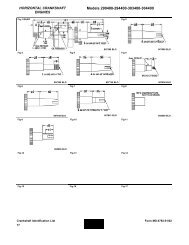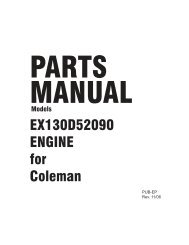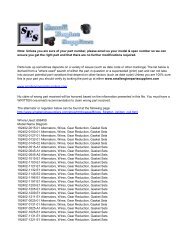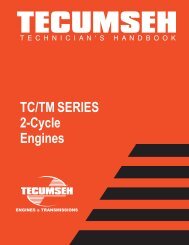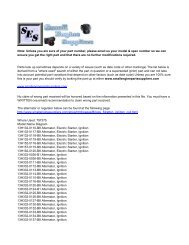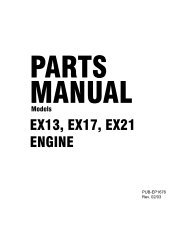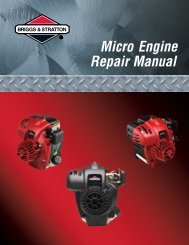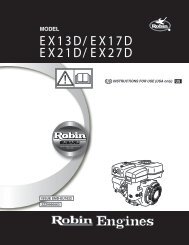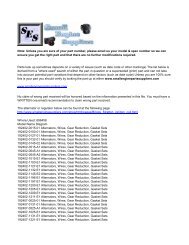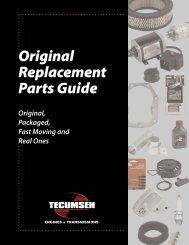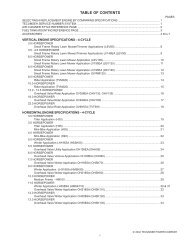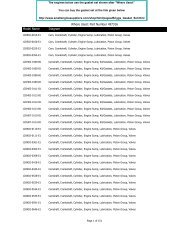3to 11hp 4-cycle l-head engines - Small Engine Suppliers
3to 11hp 4-cycle l-head engines - Small Engine Suppliers
3to 11hp 4-cycle l-head engines - Small Engine Suppliers
You also want an ePaper? Increase the reach of your titles
YUMPU automatically turns print PDFs into web optimized ePapers that Google loves.
CHAPTER 9 INTERNAL ENGINE AND CYLINDER<br />
GENERAL INFORMATION<br />
This chapter covers the cylinder block, piston and rod assemblies, cylinder <strong>head</strong>, crankshaft, camshaft, valve train,<br />
breather, cylinder cover, flywheel, counterbalance systems, and lubrication systems. The governors and the governor<br />
systems are covered in Chapter 4.<br />
All Tecumseh <strong>engines</strong> covered in this manual are four <strong>cycle</strong> <strong>engines</strong> with the valves in the engine block. The crankshaft<br />
position is designated as either horizontal or vertical as the engine rests on its base. The <strong>engines</strong> identified by decals<br />
or model as XL (Extra Life) or XL/C (Extra Life / Commercial ) are made using aluminum alloy diecast around a cast<br />
iron cylinder liner. However, not all <strong>engines</strong> with cast iron cylinder liners are identified as XL or XL/C. <strong>Engine</strong> blocks of<br />
the heavy frame series (HH, VH) are made of cast iron. All other <strong>engines</strong> use aluminum alloy for the cylinder block<br />
along with pistons that are chromium plated.<br />
OPERATION<br />
4-CYCLE ENGINE THEORY<br />
All 4-<strong>cycle</strong> <strong>engines</strong> require four piston strokes to complete<br />
one power <strong>cycle</strong>. The flywheel on one end of the<br />
crankshaft provides the inertia to keep the engine running<br />
smoothly between power strokes.<br />
The camshaft gear is twice as large as the mating gear<br />
on the crankshaft so as to allow proper engine valve timing<br />
for each <strong>cycle</strong>. The crankshaft makes two revolutions for<br />
every camshaft revolution.<br />
1. INTAKE. The intake valve is open and the exhaust<br />
valve is closed. The piston is traveling downward<br />
creating a low pressure area, drawing the air-fuel<br />
mixture from the carburetor into the cylinder area<br />
above the piston (diag. 1).<br />
2. COMPRESSION. As the piston reaches Bottom Dead<br />
Center (BDC) the intake valve closes. The piston then<br />
rises, compressing the air-fuel mixture trapped in the<br />
combustion chamber (diag. 2).<br />
3. POWER. During this piston stroke both valves remain<br />
closed. As the piston reaches the Before Top Dead<br />
Center (BTDC) ignition point, the spark plug fires,<br />
igniting the air-fuel mixture. In the time it takes to ignite<br />
all the available fuel, the piston has moved to Top<br />
Dead Center (TDC) ready to take the full combustive<br />
force of the fuel for maximum power during downward<br />
piston travel. The expanding gases force the piston<br />
down (diag. 3).<br />
4. EXHAUST. The exhaust valve opens. As the piston<br />
starts to the top of the cylinder, the exhaust gases<br />
are forced out (diag. 4).<br />
After the piston reaches Top Dead Center (TDC), the four<br />
stroke process will begin again as the piston moves<br />
downward and the intake valve opens.<br />
INTAKE<br />
COMPRESSION<br />
1 2<br />
POWER EXHAUST<br />
3 4<br />
72



